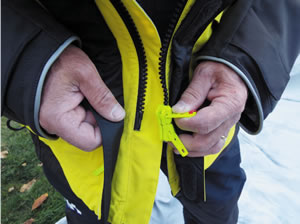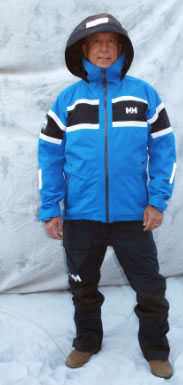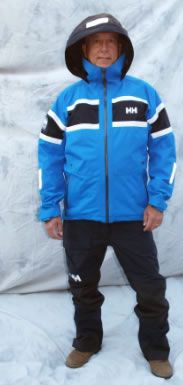

Each foul-weather garment was subject to a series of rigorous tests designed to measure resistance to the elements, breathability, wearability, reflectivity, functionality, and abrasion resistance.
Abrasion-resistance test: Testers wore each kit and crawled 100 feet over gravel on both belly and back, then examined the garment for wear.
Water-resistance test: Testers showered while wearing each kit for five minutes to determine whether the hood, neck closures, and extremity fasteners would keep out water. In a second test, jacket-clad testers immersed a properly adjusted jacket sleeve into a bucket of water for 60 seconds to test the water tightness of the inner cuff.
Wind-resistance test: Wearing only the foulie jacket and trousers (no shirt, pants or long johns), testers stood for five minutes before a pair of powerful, industrial-strength fans (same used by firefighters to eject smoke from buildings). The test determined whether the foulie material, drawstrings, storm flaps, and other closures adequately kept out wind.
Zipper and fastener test: All primary zippers were zipped up and down at least 40 times to determine whether they could withstand heavy-duty use and still operate smoothly. The zippers were evaluated for wear, YKK design, and pull tab size (to ensure it could be used with cold or gloved hands). Velcro fasteners were opened and closed 200 times each, then testers noted whether there was loss in the ability to adhere.
Reflectivity test: Each kit was taken into a dark room where a flashlight was shined to examine the garments reflective properties. These tests focused on reflective patches and piping, typically found on jacket shoulders, hood and chest. Testers also considered reflective patch placement. We prefer patches on the hood, shoulders, wrists, and chest.
Wearability test: Testers wore each kit while sailing to assess overall comfort and functionality. Factors included whether the garment was tailored to allow range of motion, chaffed the wearer due to rough seams, provided fleece at the collar, or had shoulder straps that dug into the skin.







































